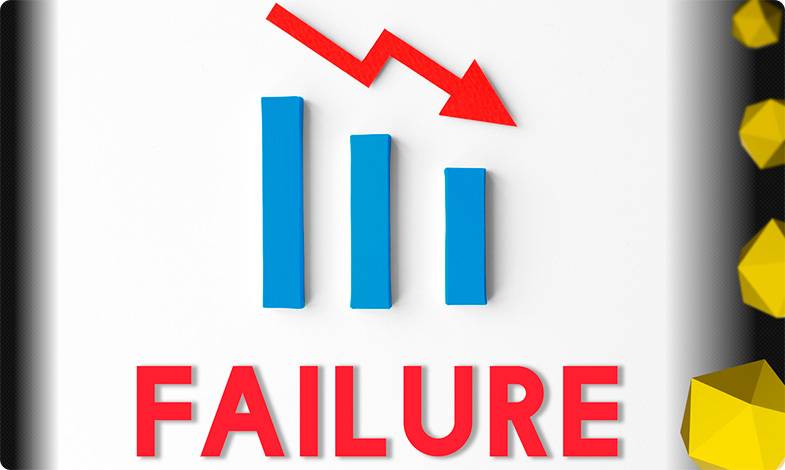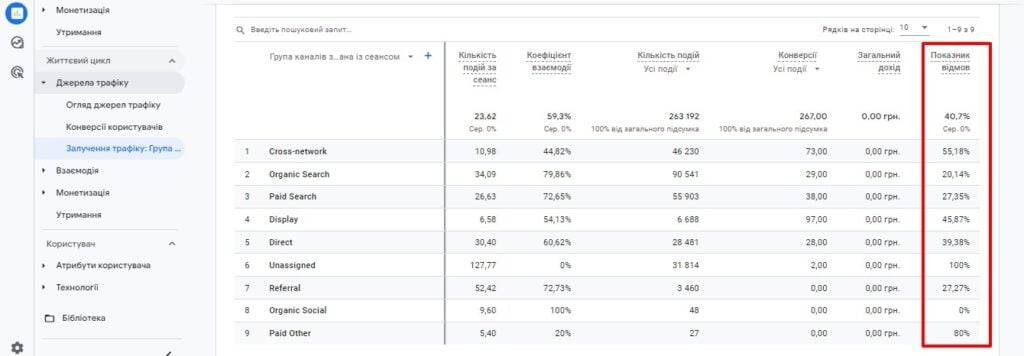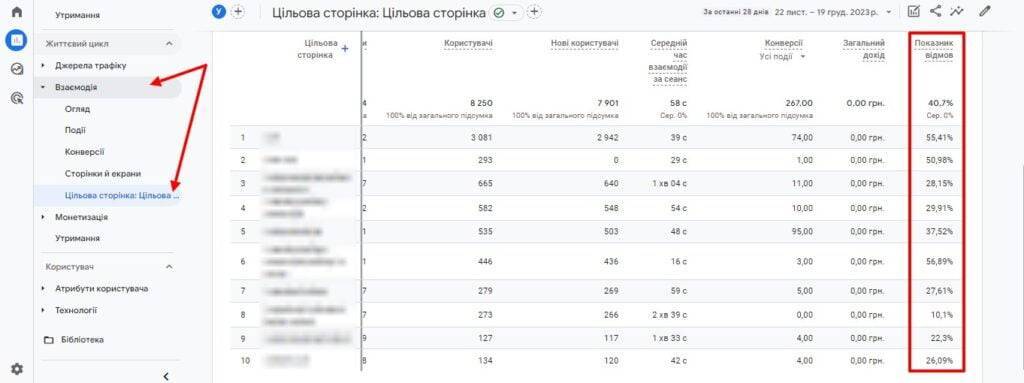Content of the article

Bounce rate is the ratio of the number of users who viewed only one page of the site to the total number of users, expressed as a percentage. In simple terms, it is the percentage of website visitors who leave without any interaction.
Every user who leaves your resource from the same page they came to without going to another page, clicking the “Learn More” button, or watching a video is considered a bounce. This value clearly shows the number of people who “came, looked and left.”
Bounce rate in Google Analytics measures the percentage of single visits to your resource. Actions that are considered failures:
- click on the “Back” button,
- ending the session
- connection failure,
- leaving for another site.
The more users leave the resource at once, the higher the bounce rate. Large values indicate that the site has some flaws.
What does bounce rate affect and why is it important?
This metric illustrates whether the site is effective overall. The higher this indicator, the more the degree of interaction with the resource decreases, and with-it sales. A high percentage of the indicator is a reason to improve the platform.
The bounce rate on a website is a behavioral ranking factor, and accordingly, it influences SEO. If the indicator is too high, search engines will understand that the resource is not optimized well enough, and it may not be shown because users do not like it.
If you don’t work with the indicator and reduce it, it will fall to the bottom of the search results. That is why this is a rather important metric that should not be neglected.
How to calculate bounce rate
To calculate your bounce rate, you need to:
Number of visitors who were on only one page of the site/Total number of visitors x 100%.
For example, if 18 out of 90 users closed the page, then the bounce rate = 18/90×100% = 20%.
There is no universal figure for all search engines. The metric also depends on the area and type of site. For example, a small percentage of failures is much more important for a store than for a blog, since these resources have completely different tasks. A blog drives traffic so that people visit other pages on the site. And an online store needs to sell goods right here and right now.
To use this metric correctly and effectively, you can measure and analyze bounce rates for specific pages or groups of pages. This plays a crucial role in understanding how users behave and can help you optimize your site.
It is also important that the bounce rate depends on the device from which they are accessing the site. Some studies show that the average failure rate for laptop and PC users is around 40%, while for smartphones it is around 60%.
What indicator is considered high?
- 70% and above is a high value that must be corrected. And the sooner the better. According to the school grading system – two.
- 50-70% is the average, usual figures for most online projects. Confident C grade.
- 30-50% is a normal bounce rate. For a four.
- 30% and below – “Excellent”! You are doing everything right.
How to Find Bounce Rate in Google Analytics
Google counts the refusal even if the user was on the page for 20 minutes, but did not perform any other actions, but simply closed it. Don’t forget to take this into account and understand that a high google analytics bounce rate is not an indicator that the site is of low quality and is not in demand.
Below we will look at how to view the bounce rate in GA.
In order to see the overall bounce rate for the site, you need to go to Google Analytics – then “Reports” – “Traffic Sources” – “Attracting Traffic”.

But then there is a nuance. Bounce rate is not shown here by default. In order for it to be displayed, you need to do the following steps: click on the pencil icon in the upper right corner, then – “Indicators” – “Add indicator” and “Bounce rate”.



After these manipulations, you will see a table in which you can study the bounce rate for the site:

Now let’s look at what needs to be done if you need to view failures for a specific resource page.
After logging into Google Analytics, also click “Reports”, then “Interaction” and “Landing Page”.
As in the previous paragraph, in order to see the bounce rate, you need to follow the same steps: pencil icon, then “Indicators” – “Add indicator” and “Bounce rate”.
After which you will see the bounce rate for a specific page.

Why do visitors leave?
Now let’s look at a number of reasons why users may leave your site:
- The site is not suitable for mobile phones. You can check whether your resource is optimized for mobile, for example, using Google Search Console.
- A lot of advertising. A large number of banners will distract the visitor from viewing the page, thereby distracting and pushing him away from your site.
- Pages of varying quality. If one page has a bounce rate of 80%, and another has a bounce rate of 20%, then the average figure for the resource will be 50%. By raising the level of failed pages, you will thus reduce the average value of the entire resource.
- Long loading time. Speed is one of the key aspects of ranking. If site pages take longer than 2-3 seconds to load, you will most likely lose potential customers and the trust of search engines.
- Pop-ups, videos, music. When a visitor searches for and views the desired content on a resource, and music starts playing from somewhere or additional windows appear that cannot be removed, this interferes, and they leave the site.
- The content does not match the requested topic. If requests lead a non-target audience to the platform, the bounce rate will increase, so you must check whether the articles are relevant to the topic and the presence of keywords.
How to reduce bounces
Improve site speed
The first time a user visits your site, you only have a few seconds to convert them into a potential buyer. And if the page takes a long time to load, then the person will simply leave the resource for competitors who have optimized their site well.
Improve UX/UI design
Small font, poorly designed navigation or sliding buttons are a common and common cause of bounce rates. You should look at the platform through the eyes of the user. You need to make sure that the page is intuitive, that important resource pages are easy to find, and that the buttons lead where you need them.
Improve your design
In addition to functionality and convenience, the resource must be modern, stylish and reflect your brand. Sites that look outdated appear abandoned and the visitor may get the impression that the company is no longer functioning. And if it doesn’t work, then there’s no point in being on the site. Therefore, it is very important to periodically redesign and keep up with the times.
Set up internal linking
Linking to other pages will also help reduce the bounce rate and increase the length of stay on the site and the depth of browsing.
High-quality targeted advertising
Don’t let in advertising impossible promises. For example, if you say that you can get a second handbag in your store completely free, but in fact it only has a 15% discount, then not only would the failure rate on the site increase, but the reputation of your resource would also suffer, and the company as a whole. But honest advertising, on the contrary, will lead to stable conversion and increase trust in the brand.
Fill your site with quality content
We are talking about content that is useful not only for search engine promotion, but also for the resource visitor. The text should be easy to read, relevant, useful and interesting, then the person will linger on the page.
A well-written text will help:
- keep the user’s attention,
- introduce him to a product or service,
- help you understand the product,
- talk about the work process,
- focus on the company’s image and more.
The main thing is to write good and relevant texts for each page. For example, for a blog you can have 20,000 characters, but for the main page there is no need for a long page.
Use interactive content
Add beautiful animations or videos to your site – this will help retain visitors, and therefore increase the time spent on the resource and reduce bounces. But don’t overdo it, such elements weigh quite a lot and can increase the page loading speed.
Let’s sum it up
In the article, we looked at what a bounce rate is, how to calculate it, and what ways you can reduce it.
A low failure rate is the foundation for successful business development. To keep it close to zero, think like a user. Provide all the necessary conditions so that the visitor not only spends more time on your site, but also returns to it. After all, you created it not for yourself, but for people. Benefit and comfort are the ideals to strive for.






 22/12/2023
22/12/2023  2447
2447



